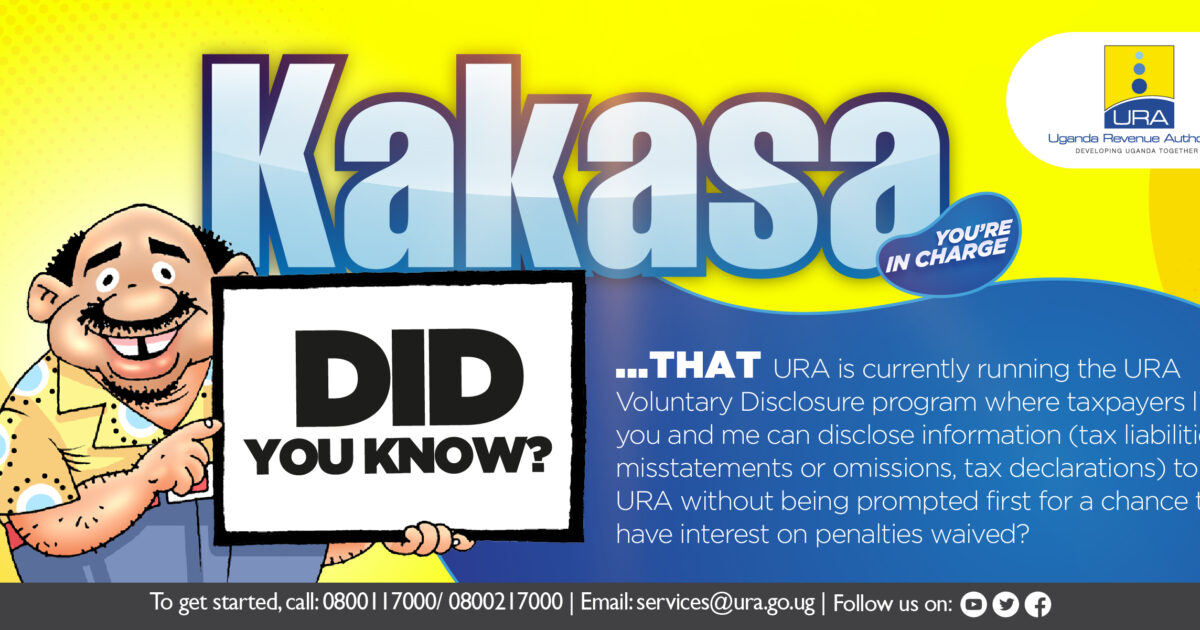On February 3, 2021, Uganda Revenue Authority (URA) launched a tax compliance campaign dubbed KAKASA-’You’re in charge’, an Integrated Communication and Marketing Campaign where URA will help usher in a new approach to doing business, allowing business men and women across Uganda to take full charge of their business destiny – from production, importation, consumption and through to record keeping.
The KAKASA Campaign is focusing on Digital Tracking Solution, and the Electronic Fiscal Receipting and Invoicing System (EFRIS). Coupled to this, is the Voluntary Disclosure Program, an olive branch extended to citizens who do not pay tax, an invitation that they become part of URA’s growing tax-paying family.
In this article, we explore in detail what Voluntary Disclosure is, how it works, how to apply for it and who stands to benefit from it.
According to URA, Voluntary Disclosure is a process where a taxpayer discloses information about his/her business to URA without any prompting by any action or threat of action by URA.
Explaining the benefits of Voluntary Disclosure, Ian Rumanyika, the Ag. Assistant Commissioner Public and Corporate Affairs at URA, says that when a taxpayer enters into an agreement with the Commissioner to pay the outstanding unpaid tax, he or she shall not be required to pay any interest or fine due.
“A taxpayer gets a fresh start. Voluntary Disclosure is more flexible and cost-efficient because it does away with litigation costs, time-effective, and gives both parties more control over the process and the results unlike arbitration,” Rumanyika says.
He adds that the Voluntary Disclosure Program is also used to correct inaccurate or incomplete information, or to disclose information not previously reported on a tax return.
How Applying for Voluntary Disclosure
Asked on the process of applying for the Voluntary Disclosure Program, Rumanyika said it’s quite simple; the taxpayer fills out the Voluntary Disclosure Form (VDF) from the URA web-portal.
The taxpayer fills in the form specifying the following: the full particulars of the taxpayer including name, business name, TIN (for registered taxpayers), address (Physical location, and postal address) telephone/ fax number and Email address; the nature of the offence committed; the period to which the disclosure relates; complete disclosure of all information about the misstatements or omissions to allow all the facts to be verified. All relevant documentation relating to the disclosure should be attached.

He adds the form should also include a declaration that the information given entails a full disclosure; Full name and signature of the person making the disclosure. (Note: for Partnership or Corporate organizations, particulars of the authorized person(s) should be included).
“The taxpayer makes payment of the principal tax due and attaches the Payment Registration Number (PRN) form highlighting the payment made; the taxpayer submits the form to any URA office near them or online via email to services@ura.go.ug,” Rumanyika says, adding that thereafter, the Commissioner General ascertains the taxpayer’s total liability connected to the offence committed including interest and penalties.
Then the Commissioner General ascertains that the taxpayer has unequivocally acknowledged committing the offence.
“The Commissioner General further ascertains that no action by URA such as a request for information, an advisory, notice of audit, query, visit by compliance officers or anything similar to this has prompted the disclosure,” he says.
The Commissioner General also ascertains that there is no pending investigation into the taxpayer’s affairs related to the offence disclosed.
“Where the Commissioner General has confirmed that the application qualifies for the Voluntary Disclosure program, he or she issues a Voluntary Disclosure Certificate to the taxpayer. Where the Commissioner General ascertains that the taxpayer does not qualify for the voluntary disclosure program, he or she issues a rejection to the taxpayer,” Rumanyika says.






